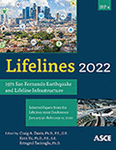Seismic Performance Assessment of Water Pipes Retrofit with Corrosion–Protection–Liner Technology
Publication: Lifelines 2022
ABSTRACT
Seismic retrofit of critical underground water pipelines, serving as a key component of lifeline networks, has become an urgent need in engineering practice to improve the performance and serviceability of these critical lifelines. The corrosion protection liner (CPL) technology consists of installing flexible plastic liners with V-shaped anchoring studs inside existing pipelines and subsequently filling cement mortar to the gap between the waterproof liner and the pipeline. With the excellent chemical resistance, impermeability, and fast construction cycles, CPL provides an economic and environmentally friendly alternative for pipeline rehabilitation without large-scale excavation. However, the lack of verification and quantification of the seismic performance of pipelines rehabilitated with CPL remains a critical deficiency for its application as an effective seismic retrofit method for underground pipelines. This study focuses on the response of CPL-strengthened ductile iron (DI) push-on joint by evaluating the liner debonding, relative joint openings produced by axial loadings simulating the seismic loading experienced by the pipeline during an earthquake event. Full-scale quasi-static tests were performed on two water-pressurized DI pipelines with push-on joints before and after reinforcement with the CPL. Moreover, based on the joint response under quasi-static loading, numerical models were developed for capturing the axial behaviors of CPL-reinforced joints that considers strength degradation and energy dissipation. Both the test results and numerical analyses indicate that CPL provides substantial axial strength to the joints of DI pipelines and improve their seismic behavior under high intensity ground motions. But the quality of the heat melting welding of CPL remains a critical uncertain factor, and poor-quality control may be adverse to the seismic performance of the retrofitted pipeline.
Get full access to this article
View all available purchase options and get full access to this chapter.
REFERENCES
Allouche, E., Alam, S., Simicevic, J., Sterling, R., Condit, W., Headington, B., and Downey, D. (2012). A retrospective evaluation of cured-in-place pipe (CIPP) used in municipal gravity sewers. Environmental Protection Agency.
ALA (American Lifeline Alliance). (2005). Design Guidelines for Seismic Resistant Water Pipeline Installations. FEMA, 255p.
Argyrou, C., Bouzioub, D., O’Rourkec, T. D., and Stewart, H. E. (2018). “Retrofitting pipelines with cured-in-place linings for earthquake-induced ground deformations.” Soil Dynamics and Earthquake Engineering, 115, 156–168.
Argyrou, C., O’Rourke, T. D., Stewart, H. E., and Wham, B. P. (2019). “Large-Scale Fault Rupture Tests on Pipelines Reinforced with Cured-in-Place Linings.” Journal of Geotechnical and Geoenvironmental,145(3): 04019004.
Dimaio, P. (2014). Introduction to Concrete Protection Liners. Geo-Frontiers: Advances in Geotechnical Engineering,1882-1891.
Hisashi, S., and Sumitomo, E. (1997). “System analysis of earthquake damage on water supply networks in Kobe City.” Proc., Proceedings of the 4th International Symposium on Water Pipe Systems, 137-145.
Jeon, S.-S., O’Rourke, T. D., and Neravali, A. N. (2004). “Repetitive loading effects on cast iron pipelines with cast-in-place pipe lining systems.” Journal of transportation engineering, 130(6), 692-705.
Li, Q., and Zhao, S. (2008). Analysis of seismic damage of engineering structures in Wenchuan earthquake, Southwest Jiaotong University Press, Chengdu, China. (in Chinese).
Loganathan, L. N., Carroll, J. O., Flanagan, R., and Weele, B. V. (2014). “Corrosion Protection Lining (CPL) for the Deep Tunnel Sewer System in Singapore-A Case History.” Proc., Geo-Frontiers Congress 2011.
MOHURD (Ministry of Housing and Urban-Rural Development of the People’s Republic of Cha). (2014). Code for seismic design of urban rail transit structures (GB 50909-2014). China Planning Press, Beijing, China. (In Chinese).
NBS (National Bureau of Statistics of China). (2019). China Statistical Yearbook. China Statistics Press, Beijing, China.
Netravali, A. N., O’Rourke, T. D., Gerritsen, K. I., Singh, Y. P., Jeon, S.-S., and Zhao, D. (2000). “Advanced Pipeline Support and Stabilized Backfill for Gas Mains,”, NYGAS.
Netravali, A., O’Rourke, T., Shaw, S., Bond, T., and Fabiano, A. (2003). “Evaluation of Starline 2000-PSE cured-in-place lining system for cast iron gas distribution pipelines.” Ithaca, NY: Cornell University,([]).
O’Rourke, T. D., Jeon, S.-S., Toprak, S., Cubrinovski, M., Hughes, M., van Ballegooy, S., and Bouziou, D. (2014). “Earthquake response of underground pipeline networks in Christchurch, NZ.” Earthquake Spectra, 30(1), 183-204.
OpenSees. the Open System for Earthquake Engineering Simulation (Version 2.5.0) [object-oriented, open source software framework]. (2017). NSF sponsored George E. Brown, Jr. Network for Earthquake Engineering Simulation (NEES). Retrieved from http://opensees.berkeley.edu/wiki/index.php/Main_Page.
Scawthorn, C., O’rourke, T., and Blackburn, F. (2006). “The 1906 San Francisco earthquake and fire-Enduring lessons for fire protection and water supply.” Earthquake Spectra, 22(2_suppl), 135-158.
Zhong, Z., Bouziou, D., Wham, B., Filiatraut, A., Aref, A., O’Rourke, T. D., and Stewart, H. E. (2014). “Seismic testing of critical lifelines rehabilitated with cured-in-place pipeline lining technology.” Journal of Earthquake Engineering. 18 (6): 964-985.
Zhong, Z. (2015). Earthquake response and rehabilitation of critical underground lifelines reinforced with cured in place pipe liner technologies under transient ground deformations, State University of New York at Buffalo.
Zhong, Z., Filiatrault, A., and Aref, A. (2017). “Numerical simulation and seismic performance evaluation of buried pipelines rehabilitated with cured‐in‐place‐pipe liner under seismic wave propagation.” Earthquake Engineering and Structural Dynamics, 46(5), 811-829.
Zhong, Z., Wang, S., Zhao, M., Du, X., and Li, L. (2018). “Performance of ductile iron push-on joints rehabilitated with CIPP liner under repetitive and seismic loadings.” Soil Dynamics and Earthquake Engineering, 115, 776-786.
Information & Authors
Information
Published In
History
Published online: Nov 16, 2022
Authors
Metrics & Citations
Metrics
Citations
Download citation
If you have the appropriate software installed, you can download article citation data to the citation manager of your choice. Simply select your manager software from the list below and click Download.
